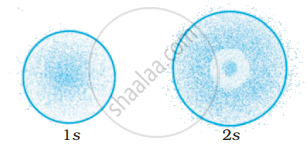Advertisements
Advertisements
प्रश्न
Match the following
| (i) Photon | (a) Value is 4 for N shell |
| (ii) Electron | (b) Probability density |
| (iii) ψ2 | (c) Always positive value |
| (iv) Principal quantum number n | (d) Exhibits both momentum and wavelength |
उत्तर
| (i) Photon | (d) Exhibits both momentum and wavelength |
| (ii) Electron | (d) Exhibits both momentum and wavelength |
| (iii) ψ2 | (b) Probability density (c) Always positive value |
| (iv) Principal quantum number n |
(a) Value is 4 for N shell |
APPEARS IN
संबंधित प्रश्न
Draw shapes of 2p orbitals.
If n = 3, what are the quantum number l and m?
The three electrons have the following set of quantum numbers:
X = 6, 1, −1, `+1/2`
Y = 6, 0, 0, `+1/2`
Z = 5, 1, 0, `+1/2`
Identify the CORRECT statement.
Which of the following has a greater number of electrons than neutrons?
(Mass number of Mg, C, O and Na is 24, 12, 16 and 23 respectively).
The probability density plots of 1s and 2s orbitals are given in Figure:

The density of dots in a region represents the probability density of finding electrons in the region.
On the basis of above diagram which of the following statements is incorrect?
Number of angular nodes for 4d orbital is ______.
Which of the following sets of quantum numbers are correct?
| `n` | `l` | `m_l` | |
| (i) | 1 | 1 | +2 |
| (ii) | 2 | 1 | +1 |
| (iii) | 3 | 2 | –2 |
| (iv) | 3 | 4 | –2 |
The arrangement of orbitals on the basis of energy is based upon their (n + l) value. Lower the value of (n + l), lower is the energy. For orbitals having same values of (n + l), the orbital with lower value of n will have lower energy.
Based upon the above information, arrange the following orbitals in the increasing order of energy.
4s, 3s, 3p, 4d
The arrangement of orbitals on the basis of energy is based upon their (n + l) value. Lower the value of (n + l), lower is the energy. For orbitals having same values of (n + l), the orbital with lower value of n will have lower energy.
Based upon the above information, solve the questions given below:
Which of the following orbitals has the lowest energy?
4d, 4f, 5s, 5p
What is the difference between the terms orbit and orbital?
